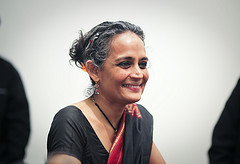World Environment Day controversy in India
While India prepares to celebrate World Environment Day, the impact of its booming economy is being questioned by activists and scholars. They argue that India’s progress is unsustainable, profited by few and is displacing thousands of India’s indigenous people.

 Booker Prize winner Arundhati Roy in her recent book 'Broken Republic', raises the issue of indigenous people in India being displaced to make way for India’s growing industries.
Booker Prize winner Arundhati Roy in her recent book 'Broken Republic', raises the issue of indigenous people in India being displaced to make way for India’s growing industries.
“In these hyper-industrialised times, multi-national corporations are rapaciously usurping land traditionally inhabited by the poor,” Roy said at her book launch last week.
India is the second fastest growing economy and the biggest democracy in the world. It is the country with most millionaires and billionaires and has become a centre for high-tech development. Attention is once again focussed on its environmental and human rights policies; in this case towards the Adivasi people – India’s 100m indigenous tribes. It has been criticised for selling indigenous lands to large corporations in Bauxite (aluminium-ore) rich areas, mainly in Eastern India. Indigenous people are displaced from their land and then forced to work collecting coal for a dollar a day.
Indian financial growth has been set amid allegations of a humanitarian and environmental crisis’ by activists and academics.
Roy says: “This ‘extract of capitalism' cannot be blindly accepted. To see natural minerals as a mere (industrial) resource is questionable. It is an example of how language has conspired to make us think in certain ways.”
Roy, a writer and activist has been fighting against the building of the Narmada Dam in central India, which has displaced up to half a million people.
By 2013 India’s economic growth is expected to overtake that of China; making it the largest growing economy in the world.
In a BBC interview on Tuesday (31 May), Roy argued that India’s growth is a lie. She stated that 800m people live on less than 20 Rupees (30p) a day and that millions are displaced from their land. “There are more, poorer people in India than in the poorest countries in Africa”, she added.
“India’s growth rate is built on taking land from the poor,” she says. “Land [for Bauxite] is being sold to large corporations who pay little royalty. We need to redefine modernity in the face of this environmental and humanitarian crisis.”
There has been social conflict in central and eastern India for almost 50 years, where Maoist supporters have fought with the Indian army. Roy argues that this is a tactic of the government to “deploy the army to fight the poorest [Adivasi] people.”
"The colonisation of the land of the poor is at the heart of the unfolding civil war in the country," Roy said.
The issue of globalisation and its impacts on indigenous people in India will be the focus of an international conference to be held in July in Perth, Australia. It will be chaired by Indian government officials and scholars. A statement issued by the conference organisers said: “Deprivation of land and forests are the worst forms of oppression that these people experience. It has resulted in the breakdown of community life and a steady cultural death or ‘ethnocide ‘.
According to an anthropological survey, it is mainly tribal indigenous areas that have faced massive development projects. Cases of displacement of tribal populations have increased in India in the past 25 years.
India is also facing accusations from environmental organisations concerned by deforestation and water pollution; nearly 30 per cent of India's gross agricultural output is lost every year due to soil degradation, poor land management and counter-productive irrigation.
Another major issue is the environmental impact of palm oil imports –India is one of the largest importers in the world.
In her book Roy poses questions to the Indian government: “Can you leave the water in our rivers, the trees in the forest, the Bauxite in the mountain?”




